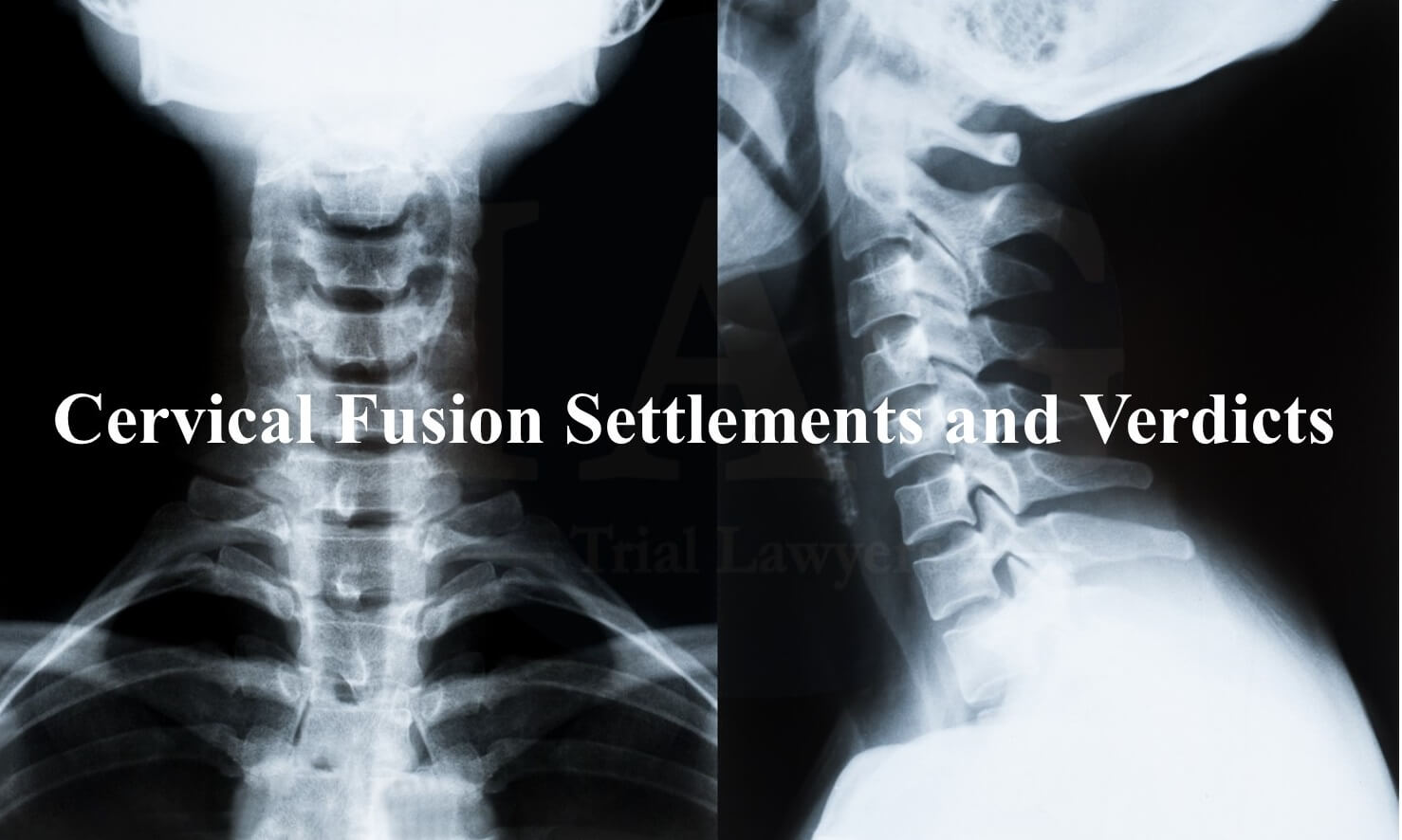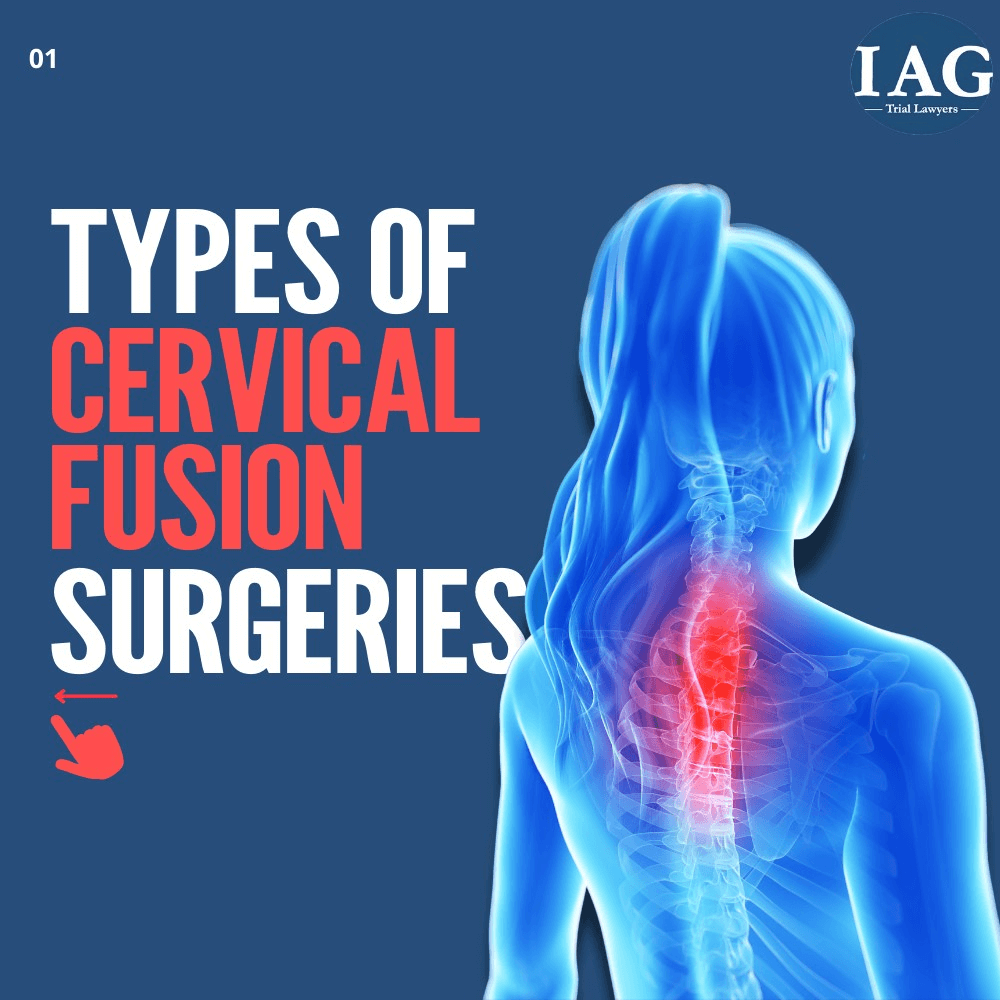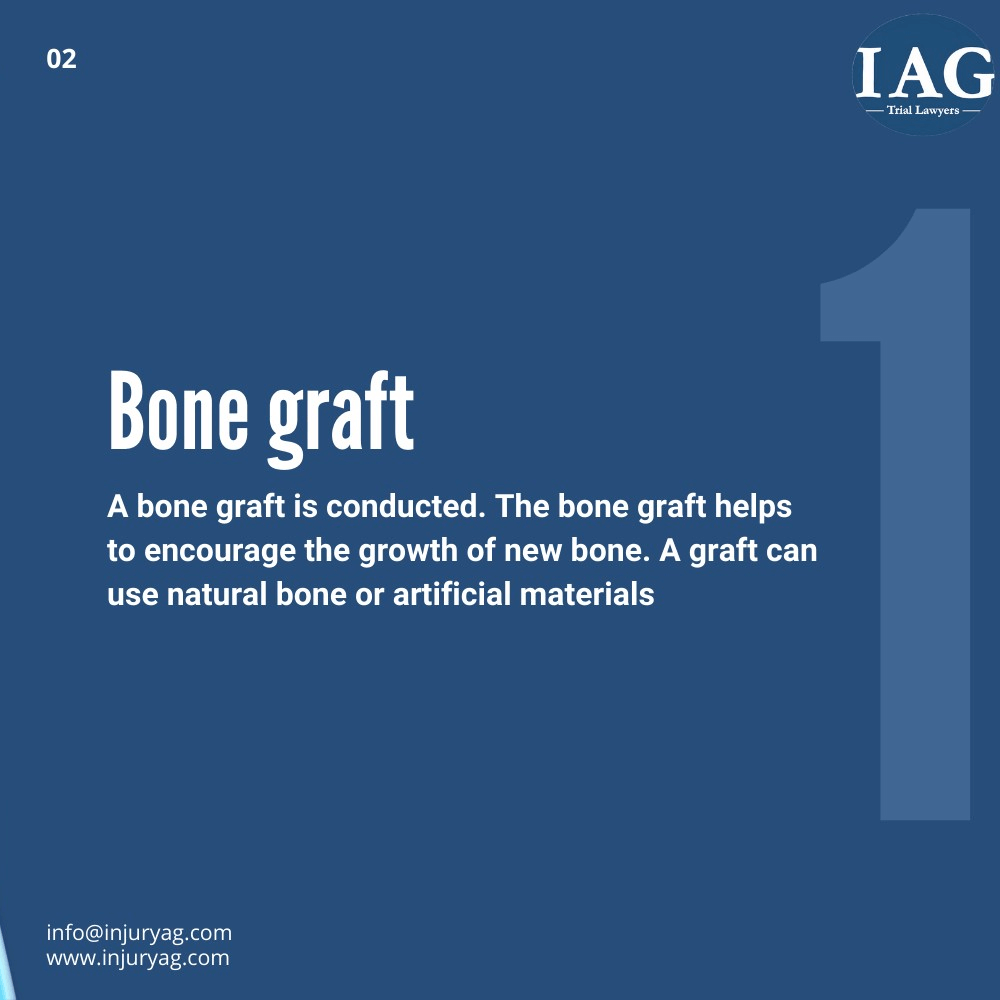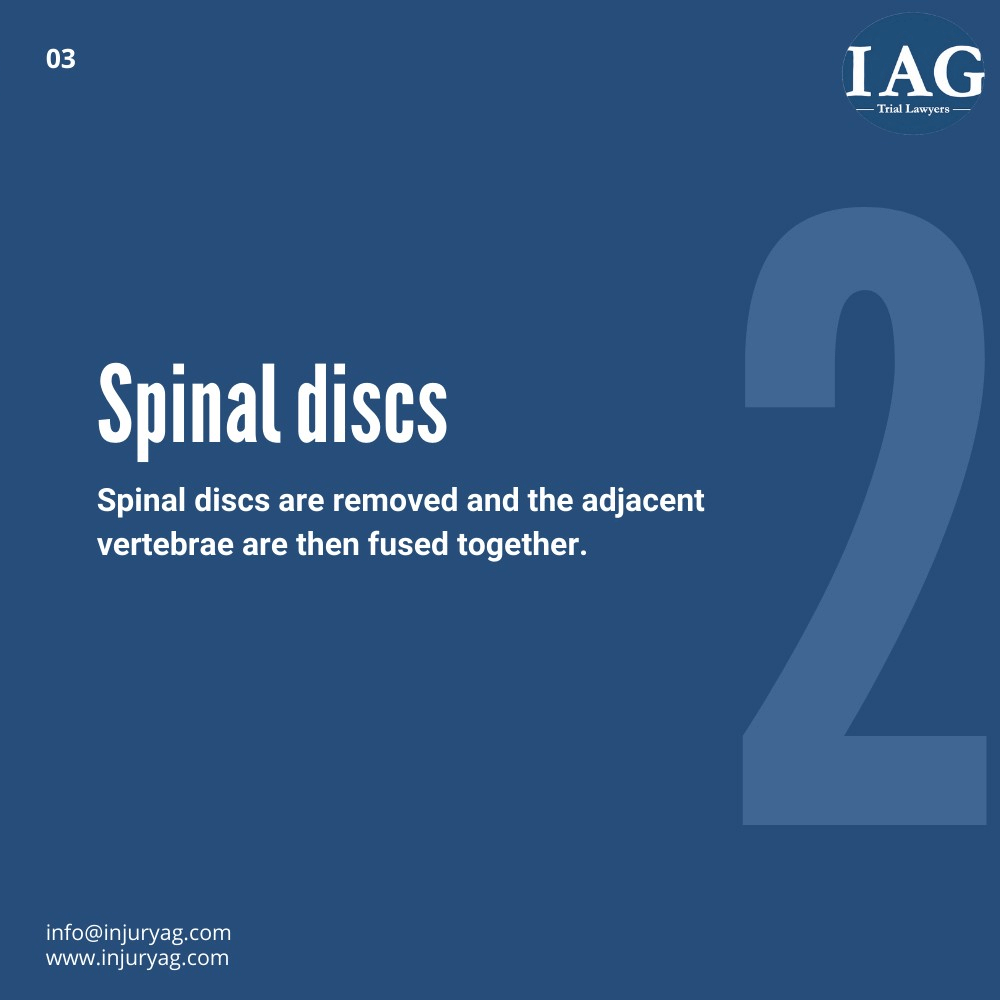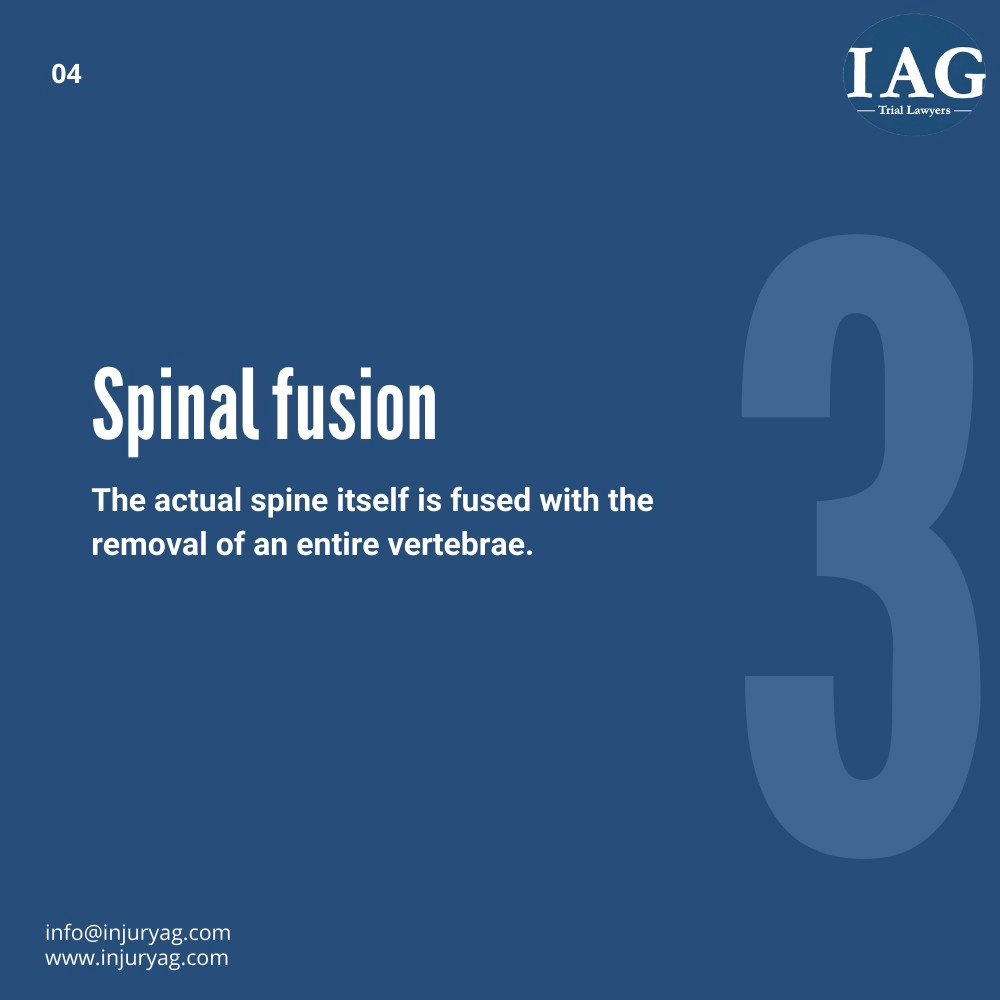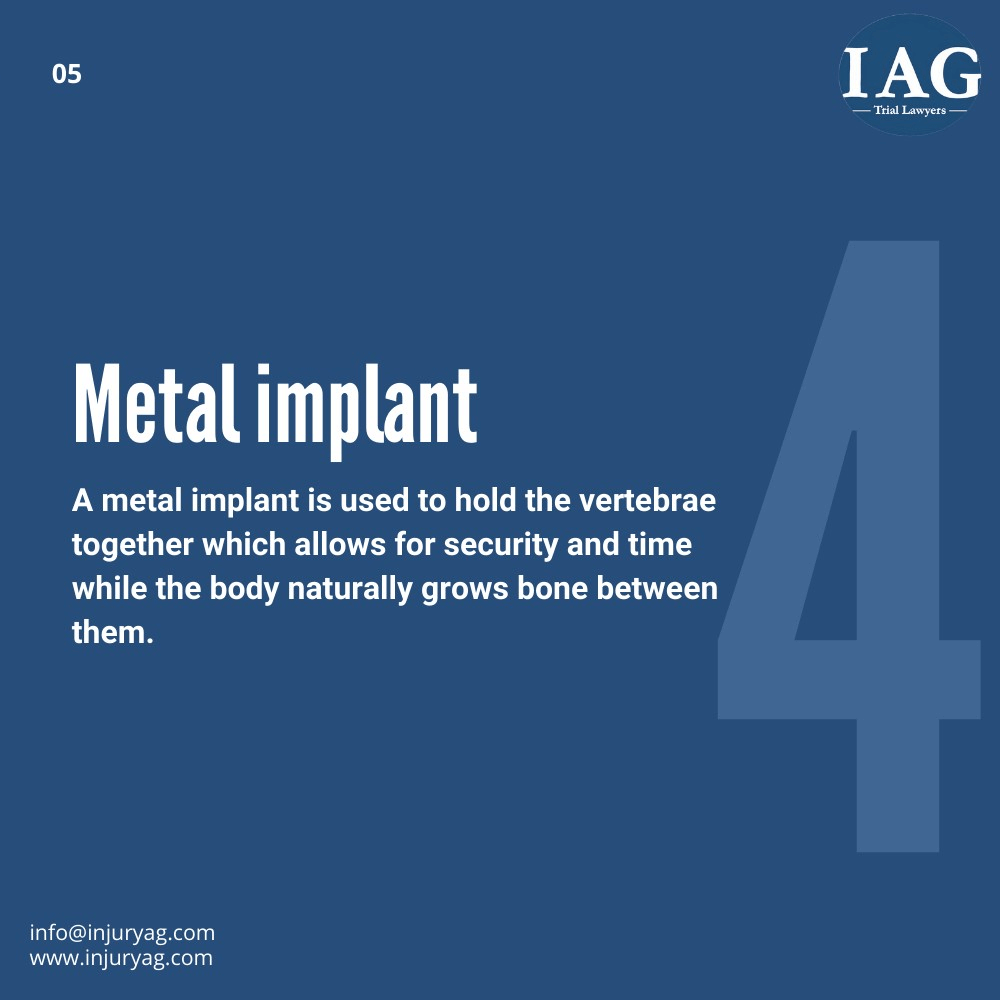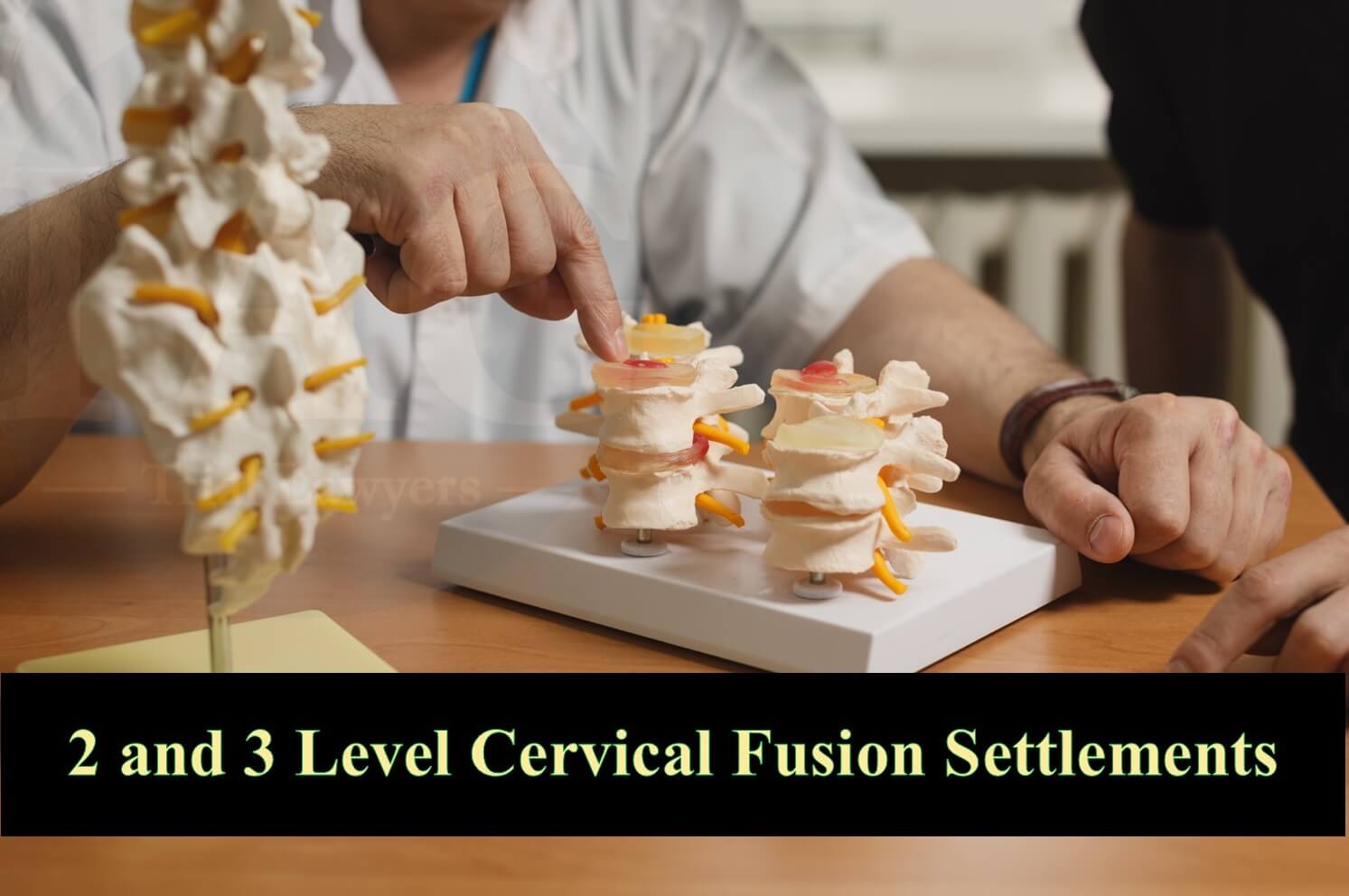Page Updated: January 31, 2022
Cervical Fusion Settlements and Verdicts
In this article you will learn everything you need to know about both cervical fusion injuries as well as cervical fusion settlements and verdicts.
The average settlement for a spinal fusion surgery depends on specifics like prior injury, impact on daily quality of life and length of recovery.
Because there are many variables that can impact the average settlement for neck fusion injuries, it is important to understand that settlement values can range a considerable amount.
In this article you will find information on:
♦ What cervical fusion injuries are
♦ The differences between 2 level cervical fusion settlements and a 3 level cervical fusion settlements
♦ Spinal fusion surgery cost with insurance
♦ Average settlement compensations for a cervical fusion injury and surgery
Scroll down to get more information on how you can maximize your cervical fusion settlement or verdict.
Clickable Table of Contents
Medical Topics
1 – What Is A Cervical Fusion?
2 – Cervical Fusion Surgery Facts
3- 2 & 3 Level Cervical Fusions
General Settlement Information
4 – Cervical Fusion Settlements and Verdicts
5 – Cervical Fusion Sample Verdicts & Settlements
Get Help
6 – Cervical Fusion Surgery Settlement Q&A
7- Get Help With Your Cervical Fusion Settlement
Article Resources
8 – Supporting Citations, Literature & Resources
9 – About the Author
What Is A Cervical Fusion?
The cervical region is another term for the neck portion of the spine.
A cervical break, fracture of injury involves damage to the bones in this upper part of the spinal region.
Any injury to this part of the body is a serious one and even the so-called “simplest” cervical surgeries are in fact major in reality.
A common solution for a cervical injury is a cervical fusion procedure because it helps stabilize and bring relief to the affected regions of the spine.
Cervical fusion surgery has many potential risks during and post-surgery and includes a long recovery time.
During a cervical spinal fusion, also known as an arthrodesis, cervical bones are joined or fused together.
Cervical fusion settlements and verdicts tend to run high exactly because of the severity of a cervical injury and the invasive and potentially risky treatments that are needed to conduct a cervical fusion.
Types of Cervical Fusion Surgeries
A cervical fusion surgery can come in many forms including removal of vertebrae, placement of screws and metal plates as well as metal implants.
Some of the most common forms of surgery for a cervical fusion are:
♦ A bone graft (bones are removed from one part of the body and used in another part) is conducted. The bone graft helps to encourage the growth of new bone. A graft can use natural bone or artificial materials
♦ Spinal discs are removed and the adjacent vertebrae are then fused together
♦ The actual spine itself is fused with the removal of an entire vertebrae
♦ Metal plates are used to join adjacent vertebrae together
♦ A metal implant is used to hold the vertebrae together which allows for security and time while the body naturally grows bone between them
Any of these surgeries will require considerable recovery time and the potential for many risks post-operation.
Just like there are many kinds of surgeries for a cervical fusion, there are also many different kinds of injuries which give rise to the need for a cervical fusion.
Cervical Fusion Surgery Facts
A cervical injury can involve one, two, three or more vertebrae in the neck. Depending on the number of vertebrae damaged, different surgeries can be used to deal with the problem.
One example of this is when a 3-level injury needs surgery which can be done with either an anterior cervical discectomy and fusion (ACDF) surgery or a hybrid surgery method, each having different potential efficacy rates and outcomes.
The more discs that need to be removed or dealt with in the surgery, the higher the possible risks are. However, even a single-level cervical fusion is a major surgery that can cause serious problems if not handled properly.
Neck Fusion Surgery Risks & Complications
Any cervical fusion surgery will carry immense risks that can cause lifelong damage and pain. Some risks are common like the potential for increased stiffness in the neck and the frequent risks that come with the use of anesthesia.
Factors that can increase risks include age as well as the existing health status of an individual. The type of surgery will also potentially increase the risks with some surgeries being more invasive, particularly if more then on vertebrae is being treated at once.
Average settlements for a spinal fusion surgery fluctuate based on factors such as these, i.e. age, type of surgery needed, problems both during or after the surgery. Risks include but are not limited to:
♦ Pain where bone was originally taken from (the graft site)
♦ Malfunction of metal plates or screws
♦ Deep vein thrombosis
♦ Bleeding
♦ Spinal cord injury
♦ Nerve damage
♦ Infections
These risks and complications can lead to not only to the need for further treatment, or additional surgeries, but also in extreme cases death. This potential is increased as there is an increase in the number cervical bones included in the surgery such as with 2 level cervical fusions and 3-level cervical fusions.
2 & 3 Level Cervical Fusions
Nearly 2 million spinal procedures are done every year and nearly half a million bone fusions of some sort making surgeries like cervical fusions very common. Cervical fusions that involve more than one vertebrae are riskier than single vertebrae surgeries and can also have a higher impact on recovery and future flexibility and mobility.
2 level cervical fusion settlement
A 2-level cervical fusion involves the removal of two discs that are next to each other. These removed discs are then replaced with artificial discs of some sort.
When an individual needs a 2-level cervical fusion they generally have one of two options, the cervical disc replacement (CDR) option or the anterior cervical discectomy and fusion (ACDF).
The CDR is used in 46% of 2-level fusion surgeries and is believed to be an efficient and cost-effective surgery for cervical injuries.
In an accident when a person needs a 2-level cervical fusion surgery settlements run as high as $3-$4 million dollars because the surgery is so intrusive and causes such long-term damage.
3 level cervical fusion settlement
3-level cervical fusion is a major surgery. Like the 2-level surgery, the 3-level surgery involves the removal of multiple discs during surgery and the placement of hardware.
When more discs are injured and hurt in an accident, there will be the need for more invasive surgery that attempts to stabilize more discs at once.
The surgery itself takes several hours and has considerable risks which is why a 3-level cervical injury has a high settlement value as well often averaging over $1 million dollars.
Part of the reason for the high values in a 3-level cervical fusion surgery settlement are that even with proper surgery with no complications, there will be loss of mobility and flexibility. This includes:
♦ Over 25% loss in side to side movement capability
♦ Approximately 15% loss in left and right turning capability
♦ Over 25% loss in backward and forward mobility.
Cervical fusions will invariably cause damage to mobility and quality of life through multiple phases which include the pre-surgery phase, the actual surgery itself and the post-operation recovery process.
C4567 Fusion Surgery
As the number of vertebrae damaged increases, so does the length of the surgery, the recovery time from the surgery and the chances of decreased mobility.
A C4567 surgery with an ACDF surgery can have an average 9 month recovery period and in some cases can take considerably longer.
The 6th and 7th vertebrae for example help to support and give flexibility to the majority of the neck and the head, and when they are damaged, there is almost a guarantee of diminished lifelong mobility in the neck which is cause for a higher settlement value.
Cervical Fusion Settlements and Verdicts

Cervical fusion settlement values will depend on the specific surgery that you have, the number of vertebrae that are injured and the length of time needed for recovery.
As noted above, 2 and 3-level surgery settlements tend to be higher than single cervical settlements because of the increased intensity in the surgery needs and recovery needs.
ACDF Surgery Settlements
ACDF (anterior cervical discectomy and fusion) surgeries and 3-level hybrid surgeries are considered to be two of the most viable and effective ways to deal with a multi-level cervical fusion case.
Both are seen as effective methods to deal with such situations, and both are believed to bring about high levels of risk and complications.
The ACDF removes a disc to help relieve pressure and address tingling, weakness and pain. A big percentage of those who have an effective surgery will still suffer from diminished mobility.
Surgery Outcome Impacts on & Settlements
Even after successful surgery range of motion was reduced in all cases of cervical damage.
While upwards of 25% reduction in range of motion was found in 3-level cervical surgeries, there was a much higher reduction in mobility with cervical surgeries like C4567 surgeries where range of motion increases after surgery included:
♦ Flexion mobility reduction (39.5%)
♦ Left and right lateral flexion (25.7 and 25.9%)
♦ Left and right rotation (18.3%)
These outcomes have a high level of impact on ultimate settlements. When the outcomes are negative and diminish the quality of life of the individual there is a higher cause for a settlement value increase.
If quality of life is altered permanently and this leads to the need for lifestyle change, inability to work regular jobs or take part in usual activities, there is also the potential for increase in settlement values and court verdicts.
Average Settlement For Neck Fusions
The average settlement for neck fusions is related mainly to how many vertebrae are involved in an accident or injury and which surgery is used for the fusion process.
♦ A single vertebrae fusion surgery averages on the low end $150,000
♦ A 2-level fusion surgery averages $250,000 on the low end
♦ a multi-level 3-4 or higher vertebrae fusion can start at $275,000 and go as high as a few million dollars
No matter which kind of surgery you get for your cervical fusion, you are guaranteed to deal with a long recovery time that will lead to you missing months of work and normal life activities.
The total disruption of your life waiting for surgery and then going through surgery and finally recovering from surgery means you will miss out on important life events, family functions, work, and will therefore lose out on income potential, job promotions and the freedom to take part in hobbies and normal day to day functions.
A spinal fusion surgery is an expensive procedure and even with insurance can be costly.
Without insurance such a surgery can cost upwards of $200,000 and even the spinal fusion surgery cost with insurance can be high depending on your deductible and specific insurance plan.
All of these factors will impact your settlement. The average nationally for cervical fusion settlements ranges from as low as $150,000 to a much higher average of over a million dollars.
Why such a broad range? For the reasons explained above, but also because of jurisdiction. Conservative jurisdictions can cut your case value down by 600% or more. Did your injury happen in a bad jurisdiction for injured victims? You have to call a lawyer to get that answer.
Cervical Fusion Sample Verdicts & Settlements
Spinal fusion car accident settlements range nationally between $150,000 and $1,000,000+. Settlements have been awarded across the country that have been related to car accidents as well as on the job injuries.
The biggest impacts on settlement are the pain and suffering caused by the injury and the subsequent treatment that is needed for the injury.
“40 year old plaintiff received a settlement after suffering a 2-level cervical injury after being rear-ended at a traffic stop”
$550,000. (NJ) SAMPLE SETTLEMENT: While stopped at a traffic stop a 40 year old man was hit from behind by a pickup truck that was speeding and was not paying attention to traffic signs. The plaintiff suffered multiple broken bones and additionally suffered 2 damaged vertebrae that needed surgery. The surgery itself was not able to return full mobility to the plaintiff and caused long-term limitations in overall functionality of the neck.
“A 42 year old man gets a higher than average settlement for a neck fusion injury after being hurt at work”
$1,450,000. (FL) SAMPLE VERDICT: While at his job an individual fell due to improper safety standards being applied. The impact of the fall damaged multiple vertebrae and resulted in the need for a multi-level fusion surgery. The injured party required vertebrae to be removed and fused together along with the addition of metal discs to help with stabilization of the neck.
Cervical Fusion Q&A
Can I recover 100% mobility and flexibility after a cervical fusion surgery?
While it is possible in some cases, the potential of returning to full flexibility even with a fusion surgery is not very high as a large percentage of those who go through a cervical fusion surgery are left with diminished mobility and range in their necks.
Will the number of damaged vertebrae impact my settlement amount?
The number of damaged vertebrae on their own will not necessarily impact your settlement amount, however, the more vertebrae you have damaged, the higher the chances are that you will require more intensive surgery and a longer recovery time, which can increase your pain and suffering value in your settlement.
What is the difference between a 2 and 3-level fusion and a C4567 fusion?
A 2-level fusion means that there will be the fusion of 2 damaged vertebrae or spinal discs while a 3-level fusion means that 3 vertebrae or discs have been damaged. A C4567 fusion is a 4 level fusion which is what separates it from the 2 and 3-level fusions.
How long is the average recovery time from a cervical fusion surgery?
The average recovery time for a cervical fusion surgery is 9 months long and some recovery times can take considerably longer than that going well over a year. However, I have had clients “recover” in four months or less.
Keep in mind that “recover” only means you’ve recovered as best as you can. It does not mean that you reached your pre-injury health condition.
Get Help With Your Cervical Fusion Claims
A cervical fusion settlement case will put you in a situation where you will be on the defensive trying to prove your injury and the impact it has on your life. Contacting a qualified and experienced attorney can help ensure that you are able to get the help you need and navigate the situation to maximize your settlement payout.
Contact us today for a free consultation on your cervical injury settlement injury.
You can call, email, or message us using the contact form below for a free consultation at anytime.

Citations for Supporting Literature & Resources:
Hyun, S. J., Kim, K. J., Jahng, T. A., & Kim, H. J. (2016). Relationship between T1 slope and cervical alignment following multilevel posterior cervical fusion surgery: impact of T1 slope minus cervical lordosis. Spine, 41(7), E396-E402.
Tang, J. A., Scheer, J. K., Smith, J. S., Deviren, V., Bess, S., Hart, R. A., … & Ames, C. P. (2015). The impact of standing regional cervical sagittal alignment on outcomes in posterior cervical fusion surgery. Neurosurgery, 76(suppl_1), S14-S21.
Marawar, S., Girardi, F. P., Sama, A. A., Ma, Y., Gaber-Baylis, L. K., Besculides, M. C., & Memtsoudis, S. G. (2010). National trends in anterior cervical fusion procedures. Spine, 35(15), 1454-1459.
Kalakoti, P., Volkmar, A. J., Bedard, N. A., Eisenberg, J. M., Hendrickson, N. R., & Pugely, A. J. (2019). Preoperative chronic opioid therapy negatively impacts long-term outcomes following cervical fusion surgery. Spine, 44(18), 1279-1286.
Shamji, M. F., Cook, C., Pietrobon, R., Tackett, S., Brown, C., & Isaacs, R. E. (2009). Impact of surgical approach on complications and resource utilization of cervical spine fusion: a nationwide perspective to the surgical treatment of diffuse cervical spondylosis. The Spine Journal, 9(1), 31-38.
Ghahreman, A., Rao, P. J., & Ferch, R. D. (2009). Dynamic plates in anterior cervical fusion surgery: graft settling and cervical alignment. Spine, 34(15), 1567-1571.
Wu, J. C., Huang, W. C., Tsai, H. W., Ko, C. C., Fay, L. Y., Tu, T. H., … & Cheng, H. (2012). Differences between 1-and 2-level cervical arthroplasty: more heterotopic ossification in 2-level disc replacement. Journal of Neurosurgery: Spine, 16(6), 594-600.
Wu XD, Wang XW, Yuan W, Liu Y, Tsai N, Peng YC, Chen Y, Wang C, Gu SY, Chen HJ, Zhou XH, He HL, Chen YY. The effect of multilevel anterior cervical fusion on neck motion. Eur Spine J. 2012 Jul;21(7):1368-73. doi: 10.1007/s00586-012-2157-7. Epub 2012 Jan 20. PMID: 22270246; PMCID: PMC3389104.
Shin, D. A., Yi, S., Kim, K. N., & Shin, H. C. (2009). Artificial disc replacement combined with fusion versus two-level fusion in cervical two-level disc disease. Spine, 34(11), 1153-1159.
Papadopoulos, E. C., Huang, R. C., Girardi, F. P., Synnott, K., & Cammisa Jr, F. P. (2006). Three-level anterior cervical discectomy and fusion with plate fixation: radiographic and clinical results. Spine, 31(8), 897-902.
Liao, Z., Fogel, G. R., Pu, T., Gu, H., & Liu, W. (2015). Biomechanics of hybrid anterior cervical fusion and artificial disc replacement in 3-level constructs: An in vitro investigation. Medical science monitor: international medical journal of experimental and clinical research, 21, 3348.
Chen, C. C., Huang, Y. C., Lee, S. T., Chen, J. F., Wu, C. T., & Tu, P. H. (2014). Long-term result of vocal cord paralysis after anterior cervical disectomy. European spine journal : official publication of the European Spine Society, the European Spinal Deformity Society, and the European Section of the Cervical Spine Research Society, 23(3), 622–626. https://doi.org/10.1007/s00586-013-3084-y
About the Author
Article Author: This law article was written by attorney Ramin Benyamin, Esquire. Mr. Benyamin received his Juris Doctor degree from the Thomas Jefferson School of Law, and his license to practice law from the State Bar of California. His law license number is #277263. He has been practicing law for ten years. Mr. Benyamin is a registered member of the following legal organizations: Consumer Attorneys Association of Los Angeles (CAALA), the Los Angeles County Bar Association (LACBA), the State Bar of California, the American Bar Association (ABA), and the American Association for Justice (AAJ). Mr. Benyamin has helped his clients recover millions of dollars in car accident claims in the State of California.
IAG Lawyers Serve Clients in Los Angeles, California & Nationally
Serving all of Los Angeles, including Arcadia, Beverly Hills, Claremont, Canoga Park, Chino, Chino Hills, Covina, Diamond Bar, Downey, East Pasadena, El Monte, Encino, Highland Park, Inglewood, La Verne, Long Beach, Malibu, Montebello, Monterey Park, North Hollywood, Northridge, Pasadena, Pomona, Rancho Cucamonga, Reseda, Rosemead, San Gabriel, San Dimas, Santa Monica, Sherman Oaks, South Bay, South LA, South Pasadena, Sunland, Tarzana, Thousand Oaks, Torrance, Van Nuys, Venice, West Covina, West Hollywood, and Westlake Village.
Serving all of California, with a focus on Kern County, Los Angeles County, Orange County, Riverside County, San Bernardino County, San Diego County, Santa Barbara County, and Ventura County.
Serving nationwide in all 50 states on a case-by-case basis with a national network of relationships and on a Pro Hac Vice basis.

